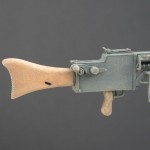
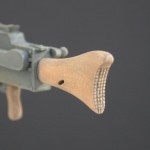
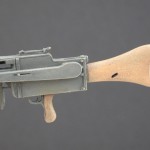
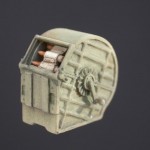
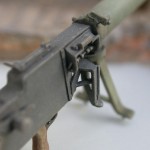
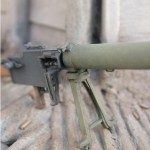
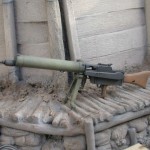
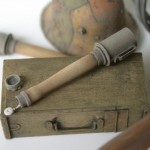
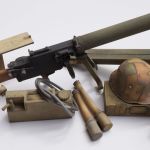
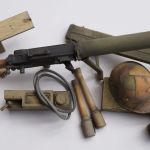
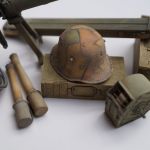
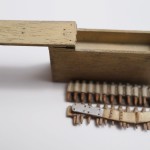
German Machine Gun 08/15 Set
- Scale / Maßstab: 1/16th (120mm)
- Material: Resin
- Parts / Teile: 27
- Infosheet / Infoblatt: English
- Code / Artikel-Nr.: 02SP
- Attention: Not a toy. Model kit or model making accessories – not suitable for children under 14 years of age. / Achtung: Kein Spielzeug. Modellbauzubehör – nicht für Kinder unter 14 Jahren geeignet
GPSR Data / Angaben
- Manufacturer / Hersteller: Jon Smith Modellbau
- Responsible Person / Verantwortliche Person
- Address: Hannoverstr. 68, 29664 Walsrode, Germany
- Contact / Kontakt: info@jonsmith-modellbau.com
- Tel: +49 (0)5161 8255
Contents:
- Machine Gun 08/15 (3 parts) / Maschinengewehr 08/15 (3 Teile)
- Standard MG 08/15 Bipod / MG08/15 Zweibein
- Rubber Steam Hose / Dampf-Schlauch
- Double-Ended Metal Spare Barrel Container for MG08 / Ersatzlaufbehälter für 2 Rohre MG08
- Drum Magazine 16 (2 parts) / Trommelmagazine oder Patronenkasten 16 (2 Teile)
- 2 Wooden Ammunition Box M1901 / 2 Patronenkasten Holz M1901
- Wooden Ammunition Box M1901 Open with Inlays (4 parts) / Patronenkasten Holz M1901 Offen mit Munitionstreifen-Einsätze (4 Teile)
- Water Container (2 parts) / Wasserkasten 15 (neuer Art) mit Ausgiesser ausgeklappt (2 Teile)
- Ammunition Belt for Drum Magazine / Patronengurt für Trommelmagazine
- 2 Stick Grenades / 2 Stielhandgranaten M.15
- Steel Helmet / Stahlhelm M.16
- Empty Ammunition Cases / Leere Patronenhülsen
- Spare Parts for MG & Water Container Assembly / Ersatzteile für MG- und Wasserkasen Zusammenbau
Extracts from the Infosheet with this kit:
Machine Gun 08/15 / Maschinengewehr 08/15: Germany’s first light machine gun – Maschinengewehr 08/15 entered service in the second half of 1916 and was available in greater numbers from 1917 onwards. Sir Hiram Maxim invented the first machine gun, and the original was patented in 1883. The need for an increase in the volume of fire, particularly in the attack and defending newly won ground, led to this somewhat cumbersome and heavy LMG. It was in reality a scaled-down version of the original MG 08, incorporating many interchangeable parts. To decrease the weight the constructors reduced the water capacity of the cooling jacket from 4 to 3 litres, redesigned the box receiver and removed the mount for the ZF12 telescopic sight. A pistol grip in place of the double-handed spaded grips and a wooden rifle type shoulder stock were added along with a lightweight bipod. A new flash hider (muzzle booster/flash suppressor) was introduced to give a better recoil action. The savings resulted in a portable MG, still weighting 43 lbs. (19.5 Kg), but with the advantages of some interchangeable parts, same function, rate of fire, ammunition (belt fed, but of different types), similar training for crews already rehearsed on the MG 08 and ease of production at the same factories.
Conflicting accounts for the correct amount of crew, or Trupp for the MG 08/15 appear to vary between 3 and 4 (2 x trained gunners and 1 or 2 ammunition carriers). A second Trupp consisting of 7 riflemen and section commander could back up this MG Trupp, or section. The two Trupps would form a Gruppe, the object being to defend the MG at all costs. It was possible with the aid of a leather sling and the 100 round drum magazine for the gun to be carried and operated by a single gunner. During firing the crank handle moves in a half cycle forwards and backwards.
Note: the separate crank handle can be attached to the rear right side of the MG block and fixed in the required position. Also, using a small drill and a knife it is possible to hollow out the space inside the breach block, allowing for the ammunition belt to be placed into the opening – here the resin has been cast as thin as possible. This can also be applied to the inside of the forward and rear sling attachment (under the barrel jacket and within the wooden stock).
The term 08/15 (spoken ´Null Acht Funfsehn´) is used in the German language to describe anything, which is ordinary, simple / crude, or to describe something senseless and apparently derived from this MG. Colour: the wooden pistol grip and shoulder stock were of a hard dark wood. The water jacket was either dark green or painted in the many different German outlined-camouflaged patterns seen on late-war steal helmets – this was in fact an official directive from the High Command, but judging from original photos seems not to be too widespread. All other parts are dark gunmetal.
Standard MG 08/15 Bipod / MG08/15 Zweibein: This entirely new pressed-steel lightweight bipod was to replace the large and heavy sled mounts used with the MG 08 and allowed for a 180° traverse. It had a universal attachment fitting, which could be fitted to the Mauser T-Gewehr – Mauser anti-tank rifle. Colour: dark green.
Note: this should fit to the MG bipod attachment. Under the release leaver (top rear of bipod) there is a small casting web – this should be removed before painting etc.
Double-Ended Metal Spare Barrel Container / Ersatzlaufbehälter für 2 Rohre MG08 oder 08/15: Designed to carry two spare barrels and a cleaning rod. This was an essential piece of equipment with the high rate of fire achieved by this weapon. Barrel changing was an important part of the training and could even be achieved whilst the barrel jacket was still full of water. Colour; grey-green with pale coloured cloth straps and reinforced leather fastener holes.
Drum Magazine / Trommelmagazine: The side mounted drum magazine (or the official name: Patronenkasten 16) made out of sheet metal and incorporating a 100 round ammunition belt enabled the operating of the gun from the slung position by a single gunner. This magazine weighed fully loaded 3.17 Kg and was attached to the receiver by means of a bracket. The small handle on the rear face had to be lifted into the up position during firing to disengage the internal drum ratchet (on the model the handle is in the locked position, preventing the belt from unwinding itself). Normal allocation per gun would be 2 drum magazines, delivered in a wooden box. The round openings at each side of the drum are the actual rotating spindle (2 small discs). Colour: dark green. Discs – metal.
Note: looking into the top one can see 2 rounds cast into the bottom of the hole. On top of these can be placed the 3 separate rounds (1 set is spare) to indicate a full magazine. A casting web is attached to the handle enabling a better flow of resin – this will need to be cut away.
Drum (Magazine) Bracket: A separate detachable bracket (+ 1 spare) is supplied with the MG to support the drum magazine. On many original photos this seems to have always been attached to the MG, regardless if drum fed or from ammunition boxes.
Note: for the correct fixing of the bracket there is an indent and small ledge under the MG feed-block. For ease of casting the recess holes within the bracket have been filled, the outside edges still visible – theses can of cause be drilled out. Pictures of a finished MG can be seen on the JSM website if the position is unclear.
Wooden Ammunition Box M1901 / Holz Patronenkasten M1901: The wooden ammunition box held a 250 round woven cotton belt with brass spacers and was used for both the MG08 and the MG08/15 (although the belts were different and not interchangeable). A push-in fastener held the lid closed with the metal handle folding into the crevice of the lid. Early models had brass handles, hinge fittings etc., later these were produced in steel. Colour: The boxes, which I had looked at had been painted originally in grey-green, with of cause the edges to the boxes quite worn. Stenciled on the lid in black were sometimes a single arrows, indicating the direction that the box should be placed next to the MG.
Note: one ammo box supplied has a detachable lid – the strips of ammunition can be painted separately and placed inside the open box afterwards. The last / top inlay has the brass bound feed tab. Plywood was used in making the original master ammunition box in order to maintain the wood grain surface on the model structure.
Ammunition Belt: The woven cotton belt with brass spacers and rounds in caliber 7.92mm. Different types of ammunition used were: standard ball, armoured- piercing and armoured-piercing tracer (1 every 10 rounds) the belts had a tendency to swell out when wet, loosening the rounds and sometimes causing stoppages. Colour: cotton belt – khaki or light yellow / brown. Case spacers – brass. Round heads – copper.
Rubber Steam Hose / Dampfschlauch: The 2 m rubber steam hose would be attached into the top of the water jacket and is to extract the vaporized water, which is then collected within the water container / can. Firing from a trench, or fixed position the MG crew, provided that they had a sufficient water supply, would bury the end of the hose to one side of the gun and thus avoid the rising white plume of steam giving their exact position away. The condensed steam can if necessary be reused to refill the water jacket. Colour: varied in colour from grey to dark matt coloured rubber – not quite black.
Water Container / Wasserkasten 15: The new type water container was used to collect the condense steam generated by the sustained firing of the MG and refill the cooling jacket afterwards. The swivel spout could be turned back into the recess of the can enabling better storage when not in use. Colour: The water cans, which I had looked at, had been painted originally in different grey-greens. Like the wooden ammunition boxes these show considerable wear and tear on outside edges.
Stick Grenade / Stielhandgranate M.15: The second type of German stick grenade to be issued (in greater numbers from 1916 onwards). The turned wooden handle would have the fuse duration stamped on one side, along with the makers name and production date. This grenade had the advantage of a screw cap, covering the porcelain ball and pulls cord igniter-system inside, keeping it dry and free from dirt. Most stick grenades were set with a 5.5 or 7-second time delay. The cap crown has 8 knurled indents to enable a better grip in wet/muddy conditions, or when wearing cloves. The metal clip on the side of the explosive charge is for attaching to equipment etc. On some original photos it can be seen that the screw caps have already been removed, ready for instant use if needed. The original master model was made using a fine grain wood to reproduce the surface of the handle. Colour: Metal parts – green/grey. Wooden stick/handle – untreated wood starts turning grey after a length of time when exposed to the elements.
Note: with a bit of care and a thin, sharp blade it is possible to hollow out the gap behind the clip and the explosive charge, not forgetting to leave the bottom part of the clip still attached.
 An deutschsprachige Interessenten:
Sie können mich per eMail oder Telefon auch gerne auf deutsch kontaktieren. Ortsbesuch ist nach Absprache möglich.
An deutschsprachige Interessenten:
Sie können mich per eMail oder Telefon auch gerne auf deutsch kontaktieren. Ortsbesuch ist nach Absprache möglich.
